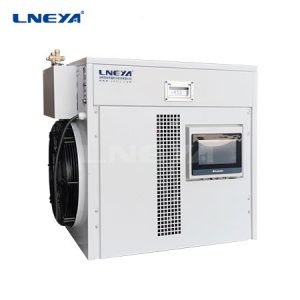Air Cooled and Water Cooled Chillers
Industrial chillers are divided into two categories, namely air-cooled chillers and water-cooled chillers. First of all, you need to determine which type you need, and you must also understand the differences between the two cooling methods, as well as price comparisons. .
The air-cooled chiller mainly consists of four main components: compressor, evaporator, condenser, and throttling device. Air-cooled chillers have the advantages of easy installation and no need for cooling tower systems, and are widely used in various industries.
1. The air-cooled chiller adopts a finned condenser, which directly uses the fan to take away the heat of the refrigerant, so no other auxiliary equipment is needed, which saves the need to install a cooling pipeline system. And it has certain advantages in installation, especially for small chillers, it is more convenient when it needs to be moved.
2. The condensing temperature of the air-cooled chiller is higher than that of the water-cooled chiller during operation. Under the same cooling capacity, the power consumption of the air-cooled chiller will be higher, and the air-cooled chiller is higher than the water-cooled chiller. The cooling capacity of the traditional type is about 300 to 500Kcal/h higher.
3. The air-cooled chiller uses a finned condenser, which is greatly affected by the accumulation of dust and scale, so the finned tubes should be cleaned regularly to avoid clogging.
The water-cooled chiller mainly uses water to dissipate heat. It uses a shell-and-tube evaporator to exchange heat between water and refrigerant. The refrigerant system absorbs the heat load in the water and cools the water to produce cold water. It is brought to the shell-and-tube condenser, and the refrigerant exchanges heat with water, so that the water absorbs the heat and then takes the heat out to the external cooling tower (belonging to water cooling) through the water pipe.
1. The water-cooled chiller is safer in operation than the air-cooled chiller, and it is more convenient for maintenance.
2. The power consumption of water-cooled chillers is less than that of air-cooled chillers, and the power consumption of water-cooled chillers is only about 70% of that of air-cooled chillers.
3. The built-in automatic water supply device saves installation and maintenance, and is especially suitable for other special occasions such as large temperature difference and small flow.
In fact, both air-cooled chillers and water-cooled chillers have their own application advantages. When choosing a chiller, you can choose a suitable type of industrial chiller based on your own environment, price and cost, and other factors.

저온 냉각기(수냉식 및 공냉식)
온도 제어 범위: -150°C ~ -5°C
당사는 -150°C의 낮은 온도 제어 범위를 갖춘 저온 냉각기 생산을 전문으로 하며, 다양한 산업의 냉장 요구 사항을 충족할 수 있습니다.
| 온도 범위 | -25°C ~ -5°C 시리즈 | -45°C ~ -10°C 시리즈 | -60°C ~ -10°C 시리즈 | -80°C ~ -30°C 시리즈 | -110°C ~ -50°C 시리즈 |
| 냉각 용량 | 최대 360kW | 최대 360kW | 최대 360kW | 최대 270kW | 최대 180kW |

재순환 냉각기 (수냉식 및 공냉식)
온도 제어 범위: -120°C ~ +30°C
당사의 재순환 냉각기는 저온 냉동 기술을 채택하고 온도가 -120℃까지 낮으며 다양한 액세서리를 사용자 정의 할 수 있습니다.
| 온도 범위 | -25°C ~ +30°C 시리즈 | -45°C ~ +30°C 시리즈 | -60°C ~ -20°C 시리즈 | -80°C ~ -20°C 시리즈 | -120°C ~ -70°C 시리즈 |
| 냉각 용량 | 최대 38kW | 최대 12kW | 최대 7.2kW | 최대 7.2kW | 최대 8.6kW |

실온 냉각기/소형 냉각기
온도 제어 범위: +5°C ~ +50°C
이 냉각기는 다양한 산업 및 실험실에서 널리 사용될 수 있으며 맞춤형 설계를 지원합니다.
| 온도 범위 | -18°C ~ +30°C | +5°C ~ +35°C 시리즈 |
| 냉각 용량 | 최대 0.9kW | 최대 50kW |

직접 냉각식 냉동 장비
온도 제어 범위: -120°C ~ -10°C
열 교환 면적이 작고 열 교환이 큰 장소에 적합합니다.
| 온도 범위 | -40°C ~ -10°C | -80°C ~ -35°C | -120°C ~ -90°C |
| 압축기 전력 | 최대 8HP | 최대 8HP*2 | 최대 45HP*3 |

직접 냉각식 초저온 냉각기
온도 제어 범위: -150°C ~ -110°C
비즈니스를 위한 맞춤형 솔루션.
| 온도 범위 | -150°C ~ -110°C |
| 냉각 용량 | 최대 11kW |

스크류 칠러
저온 스크류 냉각기 및 실온 스크류 냉각기
비즈니스를 위한 맞춤형 솔루션.
| 온도 범위 | +5°C ~ +30°C | +5°C ~ +30°C | +5°C ~ +30°C | +5°C ~ +30°C | -25°C ~ +5°C | -25°C ~ +5°C |
| 냉각 용량 | 최대 1027kW(단일 컴프레서) | 최대 2134kW(듀얼 컴프레서) | 최대 934kW(단일 컴프레서) | 최대 1940kW(듀얼 컴프레서) | 최대 467kW(단일 컴프레서) | 최대 497kW(단일 컴프레서) |
 LNEYA
LNEYA
 简体中文
简体中文


















































































